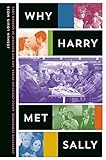Why Harry Met Sally : Subversive Jewishness, Anglo-Christian Power, and the Rhetoric of Modern Love / Joshua Louis Moss.
Material type: TextPublisher: Austin : University of Texas Press, [2021]Copyright date: ©2017Description: 1 online resource (360 p.)Content type:
TextPublisher: Austin : University of Texas Press, [2021]Copyright date: ©2017Description: 1 online resource (360 p.)Content type: - 9781477312841
- 791.43/6529924 23
- PN1995.9.J46 M67 2017
- online - DeGruyter
| Item type | Current library | Call number | URL | Status | Notes | Barcode | |
|---|---|---|---|---|---|---|---|
 eBook
eBook
|
Biblioteca "Angelicum" Pont. Univ. S.Tommaso d'Aquino Nuvola online | online - DeGruyter (Browse shelf(Opens below)) | Online access | Not for loan (Accesso limitato) | Accesso per gli utenti autorizzati / Access for authorized users | (dgr)9781477312841 |
Frontmatter -- Contents -- Acknowledgments -- Introduction Sally’s Orgasm -- Part One the first wave: the mouse-mountains of modernity (1905–1934) -- Introduction -- Chapter 1 Disraeli’s Page performative jewishness in the public sphere -- Chapter 2 Kafka’s Ape literary modernism, jewish animality, and the crisis of the new cosmopolitanism -- Chapter 3 Abie’s Irish Rose immigrant couplings, utopian multiculturalism, and the early american film industry -- Part Two the second wave: erotic schlemiels of the counterculture (1967–1980) -- Introduction -- Chapter 4 Benjamin’s Cross israel, new hollywood, and the jewish transgressive (1947–1967) -- Chapter 5. Portnoy’s Monkey: Postwar Literature, Stand-Up Comedy, and the Emergence of the Carnal Jew (1955–1969) -- Chapter 6 Katie’s Typewriter hollywood romance, historical rewrite, and the subversive sexuality of the counterculture (1967–1980) -- Part Three the third wave: global fockers at the millennium (1993–2007) -- Introduction -- Chapter 7 Spiegelman’s Frog coded jewish metamorph and christian witnessing (1978–1992) -- Chapter 8 Seinfeld’s Mailman global television and the wandering sitcom (1993–2000) -- Conclusion Plato’s Retweet -- Notes -- Selected Bibliography -- Index
restricted access online access with authorization star
http://purl.org/coar/access_right/c_16ec
From immigrant ghetto love stories such as The Cohens and the Kellys (1926), through romantic comedies including Meet the Parents (2000) and Knocked Up (2007), to television series such as Transparent (2014–), Jewish-Christian couplings have been a staple of popular culture for over a century. In these pairings, Joshua Louis Moss argues, the unruly screen Jew is the privileged representative of progressivism, secular modernism, and the cosmopolitan sensibilities of the mass-media age. But his/her unruliness is nearly always contained through romantic union with the Anglo-Christian partner. This Jewish-Christian meta-narrative has recurred time and again as one of the most powerful and enduring, although unrecognized, mass-culture fantasies. Using the innovative framework of coupling theory, Why Harry Met Sally surveys three major waves of Jewish-Christian couplings in popular American literature, theater, film, and television. Moss explores how first-wave European and American creators in the early twentieth century used such couplings as an extension of modernist sensibilities and the American “melting pot.” He then looks at how New Hollywood of the late 1960s revived these couplings as a sexually provocative response to the political conservatism and representational absences of postwar America. Finally, Moss identifies the third wave as emerging in television sitcoms, Broadway musicals, and “gross-out” film comedies to grapple with the impact of American economic globalism since the 1990s. He demonstrates that, whether perceived as a threat or a triumph, Jewish-Christian couplings provide a visceral, easily graspable, template for understanding the rapid transformations of an increasingly globalized world.
Mode of access: Internet via World Wide Web.
In English.
Description based on online resource; title from PDF title page (publisher's Web site, viewed 26. Apr 2022)


